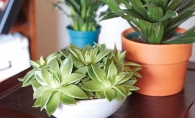We asked the managers of Dundee Garden Center and Bachman’s to share their best tips for starting the growing season off right. Here’s what they had to say.
“At this time of the year, the main consideration is the weather,” says Renae Chesley, store manager at Bachman’s in Plymouth. “A lot of plants can’t be put outside until the temperature is consistently above 50 degrees.” She recommends waiting until after May 10, the average last frost date for our region, while Gill Landis of Dundee Nursery uses Mother’s Day as a reference. The two fall on the same day this year, so once you finish celebrating Mom (or being celebrated, as the case may be), it’s time to dust off and dirty up those garden gloves.
Both experts suggest kicking off the growing season with cool weather vegetable crops such as peas, kale, cabbage, spinach, broccoli, cauliflower, parsnips, Swiss chard, radishes and lettuce. “If we have a snow, they would [still] need to be protected,” Chesley cautions. “Always keep a covering nearby.” Protect your garden with burlap or fabric frost cloths (available at both garden centers) or use an old bed sheet.
“[In May] you can start planting perennials, [which] are generally acclimated to the cooler temperatures and can survive at just above freezing,” Landis says. “You cannot do that with greenhouse-grown annuals; they need 50 degrees or higher.”
Around mid-month, you can plant sweet corn and transfer potted roses, snap beans, cucumbers and rutabaga outdoors. For lima beans, melons, pumpkins and squash, you should wait until after the 15th. Annuals including petunias, begonias, marigolds, geraniums and zinnias as well as warm-weather vegetables such as tomatoes, peppers, sweet potatoes and eggplant are particularly chill-prone, and you may want to wait until the last week of May or even early June to plant them.
“Once the temperature is in the high 40s, you can climatize plants started indoors,” Landis says. “Put them in semi-shaded location during the day and bring them inside at night. [Do this] for a week to ten days.” He warns against subjecting the transitional plants to direct sunlight: “It’s a pretty common mistake. If you start a plant by a window, it has UV protection. Outside, it doesn’t. It’ll get sunburn. The leaves turn brown and scabby.”
Some bulbs that were put in during the fall will surface before the ground has fully thawed. As your crocuses, alliums, daffodils, hyacinths and tulips bloom, apply a thin layer of mulch, as well as a fertilizer. It is important to trim down the stems and remove “spent bulbs,” Landis says. However, you should avoid removing all of the foliage as this provides the fuel for the plant’s next cycle.
May is one of the best times of the year to amend the soil with fertilizer (artificial or organic) and combat weed invaders like crabgrass and creeping Charlie. “Call a local garden center to find out if soil temperature is suitable,” Landis says. Or, watch for forsythia; the most effective time to put down crabgrass preventer is between the forsythia and lilac blooms. To prevent dandelion seeds from germinating, Landis recommends applying a weed preventer like Preen.
See that you have the proper tools, in proper condition. “Most people need a hand shovel, rake and long-handled shovel,” says Landis. Ensure that your mower is in working order, too. Grass grows more quickly in early spring and may require more than one weekly trimming.









